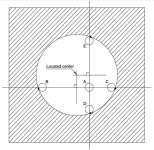markpuglia
Plastic
- Joined
- Oct 1, 2017
Is there an advantage one way versus the other to probing a bore? On a bore gauge, they have three tangent surfaces to the bore you are measuring but in probing is the existence of a 3-point bore purely to shave cycle time, or does this help eliminate any inherent pure x or y axis error/backlash? I always would assume the more points the better (ie on a CMM probing a bore)



